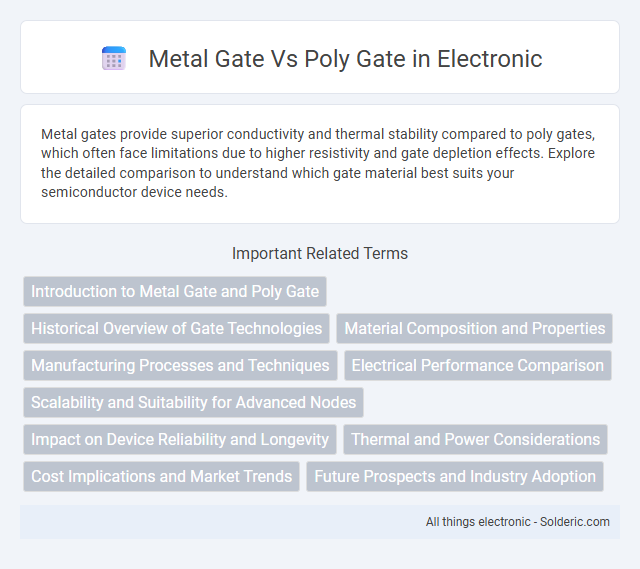Metal gates provide superior conductivity and thermal stability compared to poly gates, which often face limitations due to higher resistivity and gate depletion effects. Explore the detailed comparison to understand which gate material best suits your semiconductor device needs.
Comparison Table
| Feature | Metal Gate | Poly Gate |
|---|---|---|
| Material | Metal (e.g., Titanium, Tantalum) | Polysilicon |
| Work Function | Fixed, dependent on metal type | Variable, depends on doping |
| Gate Leakage | Lower | Higher |
| Compatibility with High-k Dielectrics | Excellent | Poor |
| Threshold Voltage Control | Precise | Less precise |
| Fabrication Complexity | Higher | Lower |
| Applications | Advanced CMOS technologies, sub-45nm nodes | Legacy CMOS, above-45nm nodes |
| Performance | Higher drive current, better speed | Lower drive current |
Introduction to Metal Gate and Poly Gate
Metal gate technology utilizes metals such as titanium, tantalum, or tungsten as the gate electrode in MOSFET devices, providing superior conductivity and reduced gate leakage compared to traditional polycrystalline silicon (poly) gates. Poly gates, made from doped polysilicon, were widely used in earlier CMOS processes but suffer from higher resistance and gate depletion effects, limiting device performance at smaller technology nodes. The shift to metal gates enhances transistor speed, scalability, and power efficiency, making them essential for advanced semiconductor manufacturing.
Historical Overview of Gate Technologies
Early semiconductor devices relied on metal gates, primarily aluminum, for transistor control, offering good conductivity but facing scalability challenges as device sizes shrank. The transition to polycrystalline silicon (poly gate) in the 1980s enabled better compatibility with silicon dioxide insulators and allowed for self-aligned gate processes, improving performance and miniaturization. Understanding this historical shift helps you appreciate how poly gates paved the way for modern CMOS technology, while recent advances are revisiting metal gate materials to overcome poly gate limitations in high-k dielectric integration.
Material Composition and Properties
Metal gates are primarily composed of transition metals such as titanium nitride (TiN), tungsten (W), or tantalum (Ta), offering excellent conductivity and thermal stability, which enhances device performance and reliability. Poly gates are made of heavily doped polysilicon, a semiconductor material with relatively higher resistivity and susceptibility to polysilicon depletion effects, impacting transistor switching speed and threshold voltage control. Metal gate electrodes provide superior work function tuning and lower gate leakage compared to polysilicon gates, enabling improved scaling in advanced CMOS technologies.
Manufacturing Processes and Techniques
Metal gate fabrication involves deposition techniques such as sputtering or atomic layer deposition (ALD) to place metals like titanium nitride or tantalum onto the substrate, followed by precise etching methods for pattern definition. Poly gate manufacturing relies predominantly on chemical vapor deposition (CVD) to deposit polysilicon films, which are then heavily doped and patterned using photolithography and plasma etching processes. Advanced integration in metal gate processes often incorporates high-k dielectrics to enhance transistor performance, contrasting with the traditional silicon dioxide gate dielectrics used in polysilicon gates.
Electrical Performance Comparison
Metal gates exhibit superior electrical performance compared to poly gates due to lower gate leakage currents and enhanced threshold voltage stability. They provide reduced short-channel effects and better drive current, which improves transistor switching speed and power efficiency. For your device optimization, choosing metal gate technology ensures enhanced reliability and energy-efficient operation at advanced semiconductor nodes.
Scalability and Suitability for Advanced Nodes
Metal Gate technology offers superior scalability compared to Poly Gate, enabling better control over short-channel effects crucial for advanced nodes below 10 nm. Its compatibility with high-k dielectrics enhances transistor performance and reduces leakage current, making it more suitable for the ever-shrinking dimensions in modern semiconductor manufacturing. You benefit from Metal Gate's improved electrostatic control, facilitating continued CMOS scaling and higher chip efficiency in advanced process technologies.
Impact on Device Reliability and Longevity
Metal gate technology improves device reliability by reducing gate leakage current and enhancing thermal stability compared to poly gate materials. The metal gate's higher work function compatibility with high-k dielectrics minimizes threshold voltage shifts, extending overall transistor longevity. Poly gates often suffer from dopant penetration and gate depletion effects, leading to increased variability and shorter device lifespan.
Thermal and Power Considerations
Metal gate electrodes offer superior thermal stability compared to poly gates, enabling higher operating temperatures without significant degradation. The lower resistivity of metal gates reduces power consumption by minimizing gate leakage currents, which is critical for energy-efficient device performance. Your choice between metal and poly gates directly impacts device reliability and power efficiency, especially in high-temperature and low-power applications.
Cost Implications and Market Trends
Metal gate technology incurs higher initial fabrication costs due to complex materials and processes compared to poly gate, which benefits from established, cost-efficient manufacturing. Market trends reveal a growing shift toward metal gates driven by superior performance and scalability in advanced semiconductor nodes, despite the cost premium. Economies of scale and technological advancements are gradually narrowing the cost gap, positioning metal gates as the preferred choice for cutting-edge electronics.
Future Prospects and Industry Adoption
Metal gate technology offers superior scalability and performance at advanced nodes, making it the preferred choice for semiconductor manufacturers targeting future technology nodes below 5nm. Poly gate, while historically dominant due to cost-effectiveness and compatibility with legacy processes, faces limitations in threshold control and leakage current reduction compared to metal gates. Your decision in choosing metal gate technology aligns with industry trends prioritizing power efficiency, speed, and device miniaturization for next-generation integrated circuits.
Metal Gate vs Poly Gate Infographic

 solderic.com
solderic.com